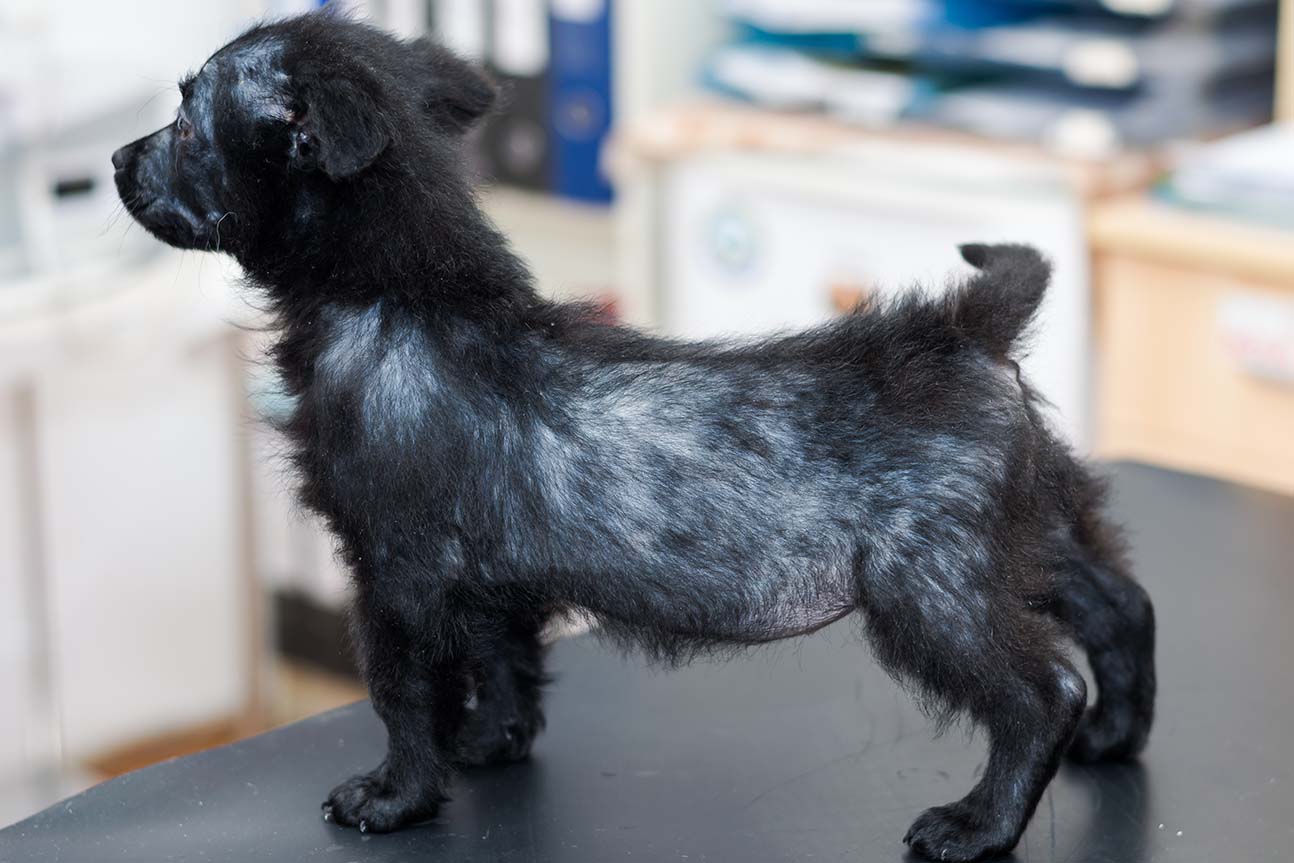Reviewed by Dr. Sarah Yosry
Updated on 25/04/2025
Reading time 4 min.
Overview
Severity: Low
Life stage: All
Dog hair loss or alopecia is often a cause of concern for any pet owner. Not only is it a disfigurement of your loving pet, but it can also be a sign of underlying health issues that need to be addressed. When a dog begins to lose hair in patches, it is essential to find the reason and seek professional advice to prevent the issue from worsening. Here we discuss the usual reasons for hair loss in patches on dogs, how to diagnose it, how it may be treated, and when to seek professional pet clinic or animal hospital advice.
Understanding Canine Alopecia
Alopecia in dogs is partial or complete hair loss on the body in any location. It may be as mild as thinning of the coat or full bald patches accompanied by skin irritation or discoloration. Seasonal or inherited hair loss may occur, yet localized patchy hair loss generally indicates that something is wrong.
The reasons for alopecia are diverse, ranging from allergies and infection to hormonal or psychological causes. Since the symptoms can mimic other conditions, proper diagnosis is critical. Hence, it is essential to see a professional in a vet clinic near me or a veterinary clinic in Dubai for thorough analysis and individualized treatment.
Common Causes of Patchy Hair Loss in Dogs
1. Allergies
Allergies to environmental components including pollen, mold, and dust mites may occur in dogs. Food allergies also occur frequently, and beef, chicken, and dairy are frequently the offending agents. Contact allergies to materials including wool or cleaning agents may also cause hair loss.
Allergic reactions generally trigger severe itching that causes dogs to scratch, chew, or lick the regions excessively, leading to hair loss in bald patches. Vets in a credible pet clinic or animal clinic can conduct allergy testing to diagnose triggers and suggest dietary or environmental modifications to control the condition.
2. Parasitic Infestations
Among the leading causes of hair loss in patches is infestation of parasites like fleas, and mites that result in mange, or lice. These parasites feed on your dog’s skin or bloodstream and cause inflammation and irritation. Mange-infected dogs show crusty, scaly skin and heavy scratching.
Timely administration of veterinary care is imperative to ensure that the infestation is not passed on to other animals or humans. Consulting a vet near me or vets near me ensures fast diagnosis and medication using antiparasitic drugs.
3. Fungal and Bacterial Infections
Ringworm is a very contagious type of infection that causes circular patches of smooth bald skin that are red and inflamed. Bacterial diseases like folliculitis also result when hair follicles get inflamed as a result of trauma, perspiration, or any other skin condition.
They both need medical attention. A clinic in Dubai can give topical or oral medications to remove the infection and stop hair loss.
4. Hormonal Imbalances
Disorders like Cushing’s disease and hypothyroidism can affect a dog’s hormonal levels and result in bilateral (symmetrical) hair loss accompanied by other related symptoms like weight gain, lethargy, or altered appetite.
Blood screening carried out in a veterinary clinic in Dubai or the vets’ hospital can diagnose them. Treatment of hormonal disorders may involve lifelong medication and follow-up.
5. Stress or Anxiety
Separation anxiety, or emotional stress on the part of the dog, resulting in changes in routine or other environmental stressors, may also result in compulsive behaviors like licking or chewing. These behaviors result in damage to the hair and skin follicles, causing bald patches.
A veterinarian or animal behaviorist in a reputable animal clinic can consult on determining the underlying cause of the anxiety and creating a behavior modification or medication program.
6. Poor Nutrition
A nutritionally defective diet—especially in essential nutrients like proteins, omega fatty acids, and vitamins—affects the coat by causing it to be dull, and leads to hair loss. Dogs require a well-balanced, species-specific diet to ensure healthy skin and hair.
Vet clinic professionals near me may be able to suggest dietary regimen and supplements to correct nutritional deficiency and stimulate hair growth.
7. Hereditary Considerations
A few specific breeds, such as Chihuahua, Dachshund, Doberman, and Greyhound, are more susceptible to hereditary alopecia. Prevalent cases are not always preventable or curable, yet in many instances, the condition can be managed by following the instruction of a veterinarian to provide comfort and reduce progression.
Symptoms to Watch
In addition to hair loss, also watch for:
• Red or inflamed skin
• Excessive licking, chewing, or scratching
• Sores, open wounds, or scabs
• dry, scaly, or flaky skin
• The smell of the contaminated regions
• Lethargy or behavioral changes
• Weight gain or loss
Observing these symptoms will require a visit to a pet clinic or a veterinary clinic to avoid complications and ensure early initiation of treatment.
Diagnosis: What To Expect At The Vet
When you visit a vet clinic in Dubai for hair loss in your dog, the vet will conduct a complete diagnostic process which may involve:
• Physical Exam: Assessing the size, shape, and positioning of hair loss, in addition to overall health markers.
• Thorough Medical History: Obtaining details on your dog’s nutrition, habits of grooming, environment, and current stressors.
• Skin scrapings: To examine for mites or fungal infections using a microscope.
• Allergy Testing: Performed via blood samples or intradermal testing to identify allergens.
• Blood Tests and Urine Analysis: To identify hormonal imbalance or dysfunction of organs.
• Biopsy: If the condition is unusual or complicated, a skin biopsy may be taken for further examination.
These diagnostic procedures narrow the possible underlying cause and individualize a treatment regimen.
Treatment Options for Patchy Hair Loss
Topical Treatment
Shampoos, creams, and sprays that are antibacterial or antifungal are generally used to cure skin infections. They relieve inflammation, kill pathogens, and spur hair growth.
Oral Medications
Your dog can be given antibiotics, antifungals, antiparasitics or hormone-regulating medications, depending on the diagnosis. Medications to reduce anxiety can be given to dogs that lose their hair due to stress.
Nutritional Support
Adding omega-3 and omega-6 fatty acids, vitamins A and E, and biotin to your dog’s diet will also increase coat quality. Your veterinarian might suggest special therapeutic diets to regain health.
Behavioural Treatment
In cases of stress-induced hair loss, treatments can involve greater physical exercise, relaxing methods, desensitization procedures, or professional behavior therapy.
Environmental Changes
Eliminating potential allergens or irritating agents in your environment and having a clean living environment can also inhibit recurrence.
Prevention Tips
To reduce the risk of hair loss in your dog:
• Bathe your dog regularly to keep them clean and healthy
• Provide a well-balanced diet specific to the dog’s breed, age, and health status
• Utilize flea, tick, and mite preventatives as recommended by your veterinarian
• Maintain your dog’s environment clean and free of allergens
• Book yearly wellness checks at a vet clinic in Dubai or an animal clinic
• Mental and physical challenges to avert stress-related conduct
Conclusion
Patchy and chronic hair loss in dogs usually indicates an underlying problem that requires professional care. If your pet exhibits alopecia symptoms, it is important to seek immediate attention to diagnose the cause and initiate treatment.
Don’t risk your dog’s health. Go to a reputable vet clinic in Dubai, like Modern Vet, where you can get top-notch diagnostics, skillful care, and empathetic service. Whether it’s a “vet near me” or a comprehensive animal clinic, you can expect to get customized care solutions that make your dog comfortable and look his or her best.
Make a booking today with leading veterinary clinic Dubai pet owners rely on, Modern Vet. Your dog’s health and well-being begin here.
Share this, choose your platform!
Writen by
Dr.Sarah Yosry
DVM
A product of a rich Australian/Egyptian heritage, Dr. Sarah Yosry stands as a testament to the union of diverse cultures and a shared love for animals.



